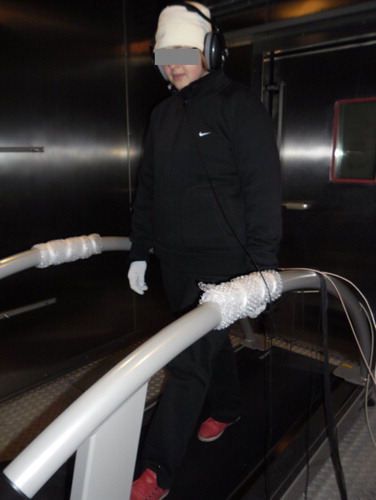Abstract
At many workstations in a cold environment, protective clothing provided for the workers is characterized by inadequate thermal insulation, which results in an adverse impact of the cold environment on the worker's body. The purpose of this article is to present developed new ergonomic modular cold protective clothing, which allows for easy adaptation of the thermal insulation of clothing to a worker's individual needs. This clothing was compared in a laboratory study with the clothing having so far been used by workers in a cold environment using physiological and physical measurements, subjective ratings of the thermal state as well as a questionnaire for subjective assessment of the used clothing. These measurements and ratings confirmed that the modular cold protective clothing is more effective in the process of ensuring thermal comfort to the wearer during work in a cold environment than the clothing having so far been used.
1 Introduction
A cold environment poses a potential hazard to health due to the possibility of cooling down the body tissues. Thermal stress in the cold environment may result in cooling down either the entire body or certain areas on the skin surface [Citation1–3]. In order to retain heat within the human body at a safe level, it is necessary to use clothing protecting against the cold and adjusted to the expected conditions of use. The optimum thermal insulation of the clothing should be selected on the basis both of the expected conditions in the thermal environment where it is to be used and of the level of the worker's physical activity. Insufficient thermal insulation of clothing will lead to cooling down of the user's body. However, too high thermal insulation will result in sweating during highly intense effort and may consequently contribute to an increase in heat losses from the user's body due to both moisture accumulation within the structure of the cold protective clothing and an increase in the thermal conductivity thereof [Citation4]. The level of sweat production of the human body depends on the type and intensity of physical activity and can increase 10 times from a resting state to very heavy physical work [Citation5]. As a result a fabric moisture content of 10–20% could cause a drop in thermal insulation of up to 50% compared to dry fabric [Citation6]. Therefore, besides the thermal insulating power, the air permeability and resistance to water vapour transmission also affect comfort during the use of the clothing protecting against the cold. These factors may affect both the thermal sensation and the degree of moisture of the clothing on the surface and between the layers thereof. Filingeri et al. [Citation7] demonstrated that moisture of the skin was a basic indicator of the sensation of cold, and therefore contributed to the feeling of thermal discomfort in the cold environment.
The type of material used affects the properties of the final product by shaping its thermal insulation and water vapour permeability as well as mass [Citation8]. Effective water vapour resistance significantly increases when the ambient temperature decreases [Citation9]. Research conducted by Wang et al. [Citation10] indicated that evaporative resistance varies depending on the body segment, as well as body and air movement. The authors stated that wind speed does not cause a significant effect, while the walking speed affects evaporative resistance on the limbs much more than that on the torso.
Air permeability is another parameter that highly contributes to dry and wet heat exchange, particularly in the case of either a high level of air velocity or increased physical activity. Air movement causes ventilation inside the clothing that contributes to drawing heat and water vapour, which depending on the working conditions can have a positive or negative effect [Citation11].
As regards the formation of worker's thermal comfort under cold environment conditions, the size of the clothing and the thickness of the layer of air retained between the clothing layers also play an important role. The degree to which the cold protective clothing fits the user's figure affects both the thermal insulation and the possibility for water vapour transmission through the set of clothing being used. Tests performed by Chen et al. [Citation12] indicated that the thermal insulation and water vapour resistance increased with the thickness of the air layer, and those values decreased after having reached the optimum point. In addition, Frackiewicz-Kaczmarek et al. [Citation13] showed varied influence of the moisture content on the clothing air gap thickness and the contact area depending on the body region. The authors noted that in most cases the air gap thickness decreased at the anterior torso and the upper back but increased at the lumbus with increasing moisture content. Besides this finding, clothing fit was indicated as a factor that is mainly responsible for the distribution of air gap thickness and the contact area. In this field, Jussila et al. [Citation14] proved that in calm conditions the static thermal insulation is higher when the mid and outer clothing layers are larger in size. The authors came to the conclusion that when air and manikin movement were added, the highest value of thermal insulation was obtained in the case when the outermost clothing size was one size larger than that recommended in Standard No. EN 13402-3:2013 [Citation15]. Further increase of clothing size led to thermal insulation decrease due to a pumping effect.
The comfort of work in the cold environment is also significantly affected by other ergonomic properties of the clothing protecting against the cold. It has been proved that cold protective clothing design has an important role in shaping its thermal insulation [Citation16]. However, mass, thickness and stiffness of the fabrics and the friction between the clothing layers may restrict the range of the user's motion, and consequently the possibility for performance of professional activities [Citation3]. High mass of cold protective clothing increases the physical effort and energy expenditure during the performance of work [Citation17].
Persons performing work in both interiors and open space under cold environment conditions should be equipped with clothing protecting against the cold [Citation18]. The employer provides the personnel working under the cold environment conditions with the cold protective clothing, which usually consists of outer clothing, while the underwear that the worker puts on under such clothing is selected individually by them, which may fail to satisfy the conditions for the removal of moisture from the skin surface to the environment. As a result, many clothing layers under outer clothing do not provide enough protection against cold conditions.
Because the two-piece clothing protecting against the cold having so far been used, with identical thermal insulating power over the entire surface thereof, fails to provide comfort to workers in the cold work environment, modular cold protective three-layered clothing has been developed. The clothing is made of knitted fabrics, woven fabrics and non-woven fabrics, selected appropriately for the functions they are going to serve, in order to ensure the removal of moisture from the skin surface to the environment. The modular clothing protecting against the cold allows the user to individually adjust the thermal insulation of the clothing to their needs. Therefore, the aim of this article was to evaluate the effectiveness of the protective properties of the developed clothing on the basis of laboratory tests with the participation of women, who are the majority of workers in production areas associated with fruit and vegetable processing under moderate cold conditions. The aim of the article is also to check whether the thermal comfort of women working with variable activity in cold environments could be provided by individual choice of protective clothing elements from a protective clothing set consisting of seven modules suitably designed for the role they should fulfil.
2 Design of the modular clothing protecting against the cold
2.1 General description
The design of clothing protecting against the cold for women working at freezers and cold stores has been developed after having learned about both the working conditions and the workers’ needs. Women working at cold stores and freezers primarily perform manual work in a fixed position, in an environment with a temperature of approximately 0 °C. The developed clothing has a modular design, what means that it comprises several elements of varying design; the worker, depending on individual needs, may select elements of the clothing on their own in order to be provided with thermal comfort during the work being performed. The clothing comprises three layers: the bottom layer, i.e., underwear, the middle layer providing additional insulation and the outer layer providing thermal insulation and characterized by increased mechanical resistance. The design of particular modules considers the functions for a given module to serve and ensures cooperation with the clothing user's body as regards heat exchange and removal of sweat in a liquid and water vapour form in order to ensure that the clothing layer being in direct contact with the skin is maintained in a dry condition and that the moisture absorption by the successive layers of the clothing is reduced. The novelty of the developed modular protective clothing is that it is characterized by zones of varied thermal insulation being adjusted to human thermal zones within the area of selected modules so that it does not cause an additional heat load or restrict the transport of moisture from the most perspiring body segments. It was assumed that the new clothing on the area of the torso, where heat production is high, will be characterized by a higher level of thermal insulation than on distal parts of the body. The clothing is also provided with a system of ventilation holes to facilitate the removal of excess heat being generated when the worker moves to an environment with a higher temperature. The fabrics used in the design of the clothing ensure that moisture is transported from the body to the environment and, due to the thermally insulating layer in the form of extra high-bulk non-woven fabric made of hydrophobic fibres, the designed clothing protects against the accumulation of moisture within the middle layer, which does not lead to a decrease in the thermal insulation thereof. In certain clothing articles, high-bulk non-woven fabric with a varied mass per square metre has been used.
A complete set of the designed heat-insulating clothing consisted of seven modules: undershirts, leggings, top, vest, raised waist trousers, internal jacket and external jacket (). More physical characteristics of the clothing are presented in Section 3.2.
2.2 The bottom clothing layer
The bottom clothing layer is the underwear presented in a, which comprises an undershirt (module 1) and leggings (module 2) with elastomeric thread, and is made of knitted fabric with a mass per square metre of 231.0 g/m2 comprised of wool and polyester.
2.3 Internal heat-insulating clothing layer
The second layer of heat-insulating clothing, which is to support thermal insulation while maintaining minimum thickness in order not to restrain movement, consists of three modules to be individually selected by the user: a top (module 3) (b), a vest (module 4) (d) and an internal jacket (module 5) (e). The long-sleeved top (module 3) is made of polyester fibre knitted fabric with a mass per square metre equal to 139.0 g/m2 which does not absorb sweat. The vest (module 4) comprises polyamide lining fabric with a mass per square metre equal to 45.0 g/m2, extra high-bulk polyester non-woven fabric with a varied mass per square metre and the outer knitted fabric made of polyamide fibres with a mass per square metre equal to 38 g/m2. In this article, increased thermal resistance was used (mass per square metre of the non-woven = 100 g/m2) on the surfaces which require the maximum insulation, i.e., on the shoulders and in the upper part of the chest and of the back. Non-woven fabric with a reduced thermal resistance (mass per square metre = 60 g/m2) was used in areas corresponding to the other parts of the back and the area of the abdomen. A set of materials with the lowest thermal resistance (mass per square metre of the non-woven = 40 g/m2), good air permeability and low water vapour resistance was used on the sides of the article in order to provide proper ventilation and evaporation of moisture in the areas where sweat is excreted.
The internal jacket (module 5) (e) comprises polyamide lining fabric (mass per square metre =45 g/m2), extra high-bulk polyester non-woven fabric with a mass per square metre equal to 60 g/m2 and polyamide outer knitted fabric (mass per square metre = 38 g/m2).
2.4 External heat-insulating clothing layer
The third (outer) layer of the clothing comprises the external jacket (module 6) (f) and trousers (module 7) (c) with a varied mass per square metre of the non-woven fabric on various areas of the jacket. The same lining fabric, high-bulk non-woven fabric and outer knitted fabric was used as in modules 3 and 4. The manner of distribution of the non-woven fabric in the external jacket is presented in and that in the trousers in .
Figure 2. Arrangement of insulating layers in the external jacket.
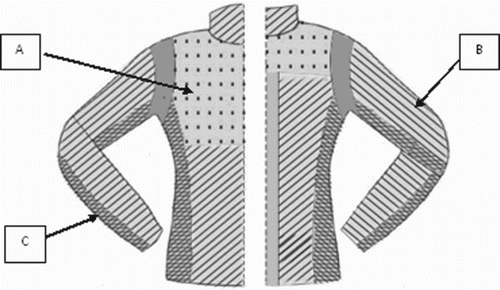
Figure 3. Arrangement of insulating layers in trousers.

In the trousers (module 7), the highest thermal insulation (mass per square metre = 100 g/m2) was provided for the middle part of the trousers, while the lowest thermal insulation (mass per square metre = 40 g/m2) was provided for the upper part. Such diversity of the mass per square metre of non-woven fabric results from the fact that the thighs are most susceptible to freezing and the knees require additional heat in a situation where the nature of the work requires a kneeling position for the clothing user. In the external jacket the highest thermal insulation (mass per square metre of the non-woven = 100 g/m2) was provided for the chest and upper back while the lowest thermal insulation (mass per square metre of the non-woven = 40 g/m2) was provided on the sides of the jacket and the inner part of the sleeves.
The developed clothing is intended for use under conditions of air temperature of approximately 0 °C for the performance of low to high-intensity work for 8 h. The estimated range of the air temperature during work for a period of 8 h varies from +7 °C in the absence of activity (standing, 75 W/m2) to –8 °C when performing light work (115 W/m2) in accordance with Standard No. EN 342:2004 [Citation19].
3 Research methodology
The tests on the designed and manufactured clothing protecting against the cold in order to compare it with the traditional, currently used protective clothing were performed under laboratory conditions with the use of a climatic chamber, in which the conditions of the thermal environment as found at the actual workstations were reproduced.
3.1 Variants of clothing items for physiological tests with the participation of volunteers
Three variants of tests were performed, using differing types of clothing protecting against the cold:
W1 – the complete set of all seven items of the designed modular cold protective clothing described in Section 2. All ventilation holes were closed. The aim of this variant was to compare human physiological responses to the variant with maximal thermal insulation of the designed clothing and the variant of the clothing which was used up to now (W3).
W2 – a set of modules of the cold protective clothing as selected individually by the person participating in the study in order to achieve thermal comfort, both prior to taking an effort in the climatic chamber and throughout the entire duration of the test. The aim of this variant was to evaluate new clothing protecting against cold in the simulated utility conditions, when workers can individually adjust selection of clothing items to their thermal state.
W3 – a set of the clothing that has so far been used at the workstation, which comprised the following elements: cotton undershirt with short sleeves, zipped fleece top and fleece top with a polo placket, zipped tracksuit top, thick tights and tracksuit trousers () – a reference variant.
In each test variant (W1, W2 and W3), the subjects put on thin cotton socks and terry socks, a woollen hat, cotton gloves and insulated boots.
3.2 Physical characteristics of protective clothing applied in the study
Values for the effective thermal insulation (parallel model) of test variant W1 in accordance with Standard No. EN ISO 15831:2004 [Citation20] and Standard No. EN 342:2004 [Citation19] of the developed modular clothing protecting against the cold W1 are provided in .
Table 1. Effective thermal insulation of particular elements of the clothing forming part of the developed women's clothing for work in the cold environment (W1).
Tests of thermal insulation properties were carried out in a climatic chamber (Weiss Umwelttechnik, Germany) using a 16-segment thermal Diana manikin, female shape (Claus Bidstrup Technical University, Denmark). In the measurements of clothing thermal insulation, a testing mode maintaining a constant temperature on the surface of the entire manikin (equal to 34 °C) was applied. Depending on the tested variant, a different amount of power was supplied to each segment of the manikin [Citation19,Citation20]. All experiments were performed in a climate chamber under constant and controlled conditions with the following parameters of the thermal environment: air temperature of 25 °C, air velocity of 0.4 m/s and relative humidity of 40%. These conditions made it possible to compare a power consumption of individual segments of the manikin. Thermal insulation in the International System of Units (SI) is expressed in m2·K/W or in clo (1 clo = 0.155 m2·K/W) in customary use. The effective value of the thermal insulation was obtained by subtracting the value of thermal insulation of additive elements of clothing (hat, gloves, socks) from the total thermal insulation.
Effective thermal insulation (Icle) of the entire set W1 amounted to 0.392 m2·K/W (2.53 clo) and of the entire set W3 was equal to 0.306 m2·K/W (1.97 clo), as determined using the parallel method in accordance with Standard No. EN ISO 15831:2004 [Citation20] and Standard No. EN 342:2004 [Citation19].
presents the mean mass values of clothing sets used in the tests.
Table 2. Mass values of clothing sets used in the tests (M ± SD).
3.3 Participants
In the study, 6 women participated with experience in working under cold conditions from 1 to 30 years (on average, 9.8 ± 11 years). Profile of the subjects: age of 41.7 ± 10.7 years; body weight of 64.9 ± 12.7 kg; body height of 161.2 ± 4.8 cm; body mass index (BMI) of 24.9 ± 4.2; daily activity of 33.0 ± 9.7 [Citation21].
Each participant took part in tests with W1, W2 and W3 sets of clothing.
3.4 Test conditions
Physical parameters of the thermal environment during the test are provided in . The test conditions were determined based on the working conditions of the women participating in the study.
Table 3. Conditions of the thermal environment during the preparation of subjects for tests and during tests in the climatic chamber.
Before walking on the treadmill wearing the tested clothing, subjects were sitting for 30 min in the laboratory.
The subject walked on the treadmill for 60 min with the following system of effort intensity:
15 min, very light effort (2 km/h);
15 min, light effort (3 km/h);
3 min of standing;
15 min, very light effort (2 km/h);
15 min, light (3 km/h);
3 min of standing.
3.5 Measured parameters
During the test, the external ear canal temperature was measured, with the sensor being isolated from the surroundings with a paraffin wax stopper, a double shield of fleece knitted fabric and a hearing protection device. The following parameters were also measured: local temperature of the skin at eight points (forehead, scapula, upper chest, arm in upper and lower location, hand, anterior thigh and calf) in accordance with Standard No. EN 9886:2004 [Citation22] and the temperature and relative humidity under the underclothing in the area of the chest and shoulder blades. Heart rate was monitored. All of these parameters were measured simultaneously using combined software in an FX 2000 cardiac monitor (Emtel, Poland). Participant body mass was measured before and after the exercise in the climatic chamber, using platform scale F150 S-D2 (Sartorius, Germany). Sweating intensity was assessed as a difference between final and initial values of body mass.
During the tests, subjective ratings concerning the thermal sensation in the body were collected every 15 min [Citation23]. After completion of the experiment, each subject filled in a questionnaire concerning the evaluation of the clothing – the set of questions is provided in the table with the results. The questionnaire was aimed at evaluation of participants’ sensations in relation to thermal comfort, humidity of clothing and also their fitting to the body.
3.5 Statistical analysis
In order to assess differences between the three test variants, analysis of variance (ANOVA) was applied. Prior to the commencement of the analysis, Levene's test was applied to assess the equality of variances. In the absence of the equality of variances, non-parametric tests (Friedman's ANOVA) were applied for the assessment of statistically significant differences. If the analysis of variance demonstrated statistically significant differences, the least significant difference (LSD) test was selected for the detailed assessment thereof. The significance level was adopted at a value of 0.05. Statistical analysis of the measured data was performed using Statistica version 9.1.
4 Test results
4.1 Individually selected set of developed clothing
The clothing variant W2 was an individually modified version of the entire set of clothing W1. At the beginning of the experiments all participants were dressed in underwear (modules 1 and 2) and then each participant selected items of the W2 clothing set in a different way, according to their own preferences. All details are presented in .
Table 4. Type and term of clothing item changes in variant W2 of the conducted study.
During the test on the W2 variant, the women could individually select particular elements of the designed clothing, and their choices varied, which indicates that under the same conditions of both work and thermal environment, the requirements for the warmth retention of the clothing vary. The women took off the top (four cases out of six); in one case, the participant did not use the jacket and external trousers and in another case, the participant did not use the jacket. In two cases, women gave up the internal jacket during the test.
4.2 Physiological and physical parameters
In the course of external ear canal temperature, slightly higher values were found in the W1 test variant throughout the entire duration of tests, compared to variants W2 and W3. The results are presented in . The differences between variants were not statistically significant.
Figure 5. Changes in the external ear canal temperature (Tac) during tests on women under conditions of air temperature of 0 °C in three variants of the clothing.

Greater diversity of results was observed in the changes in the mean weighted temperature of the skin (). The most stable course of that parameter was observed under the W1 variant conditions, which was associated with changes in the range of mean values between 32.2 and 32.5 °C. In that test variant, the level of
was statistically significantly higher (p < 0.05) than in both other variants (W2 and W3). In the W2 variant, the initial drop by 0.7 °C was followed by stabilization of
at the level of 31.0 °C. As regards the W3 variant, a gradual and systematic decrease in
is observed, which, in the case of longer-lasting exposure, will lead to cooling down of the body surface. In the final phase of the study, statistically significant differences were also found between the W2 and W3 variants (). In the last phase of the experiment, the temperature dropped below 30.0 °C, which may be indicative for thermal discomfort.
Figure 6. Changes in the mean weighted skin temperature () during tests on women under conditions of air temperature of 0 °C in three variants of the clothing. *p < 0.05
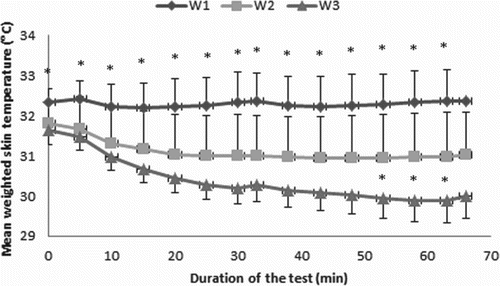
Measurement results for the temperature and relative humidity under the underwear are presented in Figures . In the W1 and W2 test variants, temperature was higher on the chest than on the shoulder blades ( and ). At the same time, the W3 variant results in a temperature level of approximately 30.0 °C, i.e., 2.0 and 3.0 °C less than in the W2 and W1 variants, respectively. Up to the 38th minute of the test, the temperature level in the chest area is statistically significantly lower in the W3 variant than in the W1 and W2 (). At the same time, in the W2 variant the temperature is statistically significantly lower as compared to the W1 variant. In turn, as from the 43rd minute of the test, only the statistically significant difference between W3 and the other variants (W1 and W2) remains.
Figure 7. Changes in temperature under the underwear on the chest during tests on women under conditions of air temperature of 0 °C in three variants of the clothing. *p < 0.05
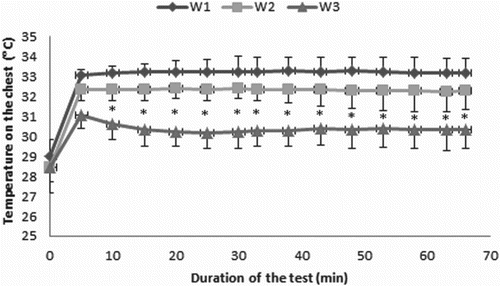
Figure 8. Changes in temperature under the underwear on the shoulder blade during tests on women under conditions of air temperature of 0 °C in three variants of the clothing. *p < 0.05
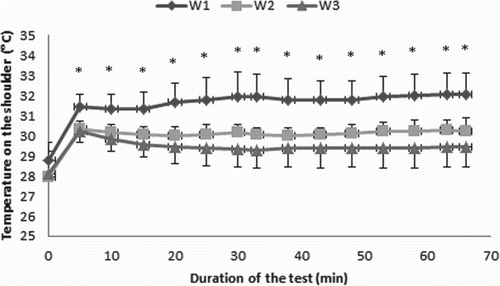
Figure 9. Changes in relative humidity under the underwear on the chest during tests on women under conditions of air temperature of 0 °C in three variants of the clothing. *p < 0.05
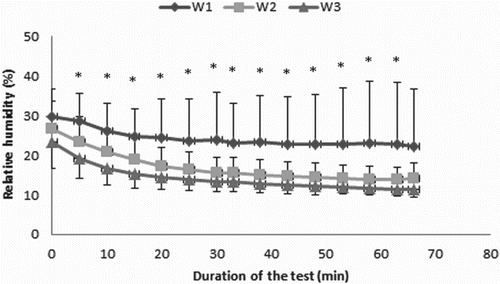
Figure 10. Changes in relative humidity under the underwear on shoulder blades during tests on women under conditions of air temperature of 0 °C in three variants of the clothing. *p < 0.05
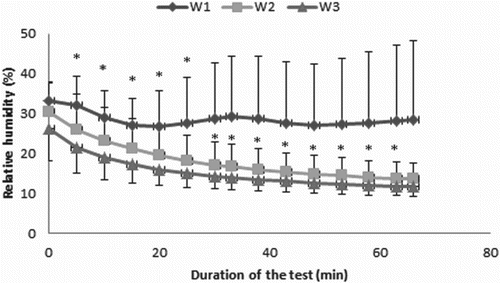
At the same time, it may be observed that in the W1 variant of the clothing (the complete set) the temperature is gradually slightly increasing under the underwear in the shoulder blade area. In the W2 variant, the temperature level does not change, and in the W3 variant there is a drop by 0.7 °C.
The temperature level under the underwear in the shoulder blade area is statistically significantly higher in the W1 variant than in the W2 and W3 variants from the 5th to the 66th minute of the test ().
In the W2 and W3 test variants, the observed drop in relative humidity under the underclothing ( and ) was more significant than in the W1 variant and the process ran more quickly during the initial 30 min of the test (8–9% on the chest and 12–13% on the shoulder blade) and then more slowly (1–2% on the chest and 2–5% on the shoulder blade), to finally reach approximately 11 and 14% of relative humidity in the W3 and W2 variants, respectively, both on the chest and on the shoulder blade. In the second part of the test, the difference in the relative humidity under the underwear between the W2 and W3 variants amounted to approximately 2% in both locations.
The level of relative humidity under the underwear in the chest area was statistically significantly lower in the W3 variant than in the W1 variant from the 5th to the 66th minute of the test.
The most stable relative humidity under the underclothing was observed on the shoulder blade in the W1 test variant, with changes being no greater than 5%, while in the W2 and W3 variants the range of changes was over two times broader. On the chest, the changes in relative humidity were similar to the changes on the shoulder blade in terms of the range, but different in terms of the quality – following the initial decrease of approximately 5%, the level thereof remained unchanged until the end of the test.
Relative humidity under the underwear on the shoulder blade was statistically significantly lower in the W3 variant than in the W1 and W2 variants from the 5th to the 25th minute, and from the 30th minute the significant difference remained between the W3 and W1 variants.
During the tests as performed, the sweating intensity was as follows: 0.086 ± 0.022 kg, 0.083 ± 0.021 kg and 0.077 ± 0.032 kg for variants W1, W2 and W3, respectively. No statistically significant differences between test variants were observed.
4.3 Subjective ratings
Results for average subjective ratings concerning the thermal sensation on the body are presented in . The differences between the clothing variants under study were not statistically significant.
Figure 11. Subjective ratings (from −4 to +4) of thermal sensation on the body during tests on women under conditions of air temperature of 0 °C in three variants of the clothing.
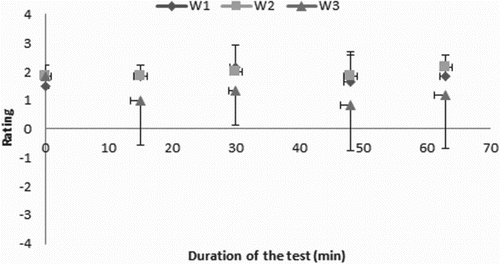
The survey ratings of the clothing are compiled in . The results obtained indicate that the subjects rated the currently used set of clothing less favourably, since fewer positive and more negative answers to the questions were obtained in that case as compared to the W1 and W2 variants. Another element of the rating, i.e., the comparison of the currently used clothing with both variants of the newly developed clothing, i.e., W1 and W2 (the question for the currently used set of clothing), is also more favourable to the models of the developed clothing since it obtained more positive answers, and thus the currently used clothing was rated as being inferior.
Table 5. Results for survey rating of the clothing variants under study.
5 Discussion of test results
Laboratory tests were performed with the participation of women having been employed under the cold environment conditions for at least 1 year. Participants with similar characteristics of daily activity and similar body dimensions were selected for the study. Such conditions allow a comparison of results obtained in different variants research. Features such as the age of the subjects, physical fitness and body size have a significant impact on the volume changes of physiological parameters [Citation24]. During the tests, those persons used the complete version of the designed clothing including all the elements thereof, or only selected the elements being appropriate to the given participant. For comparison, the clothing having so far been used was used for tests.
Results of the study indicated that the complete set of clothing (W1), comprising seven modules, had a certain reserve of warmth retention and consequently a higher effectiveness of the complete set of clothing in protecting the body against cooling down as compared to the clothing in the W2 variant associated with the individual selection of the clothing modules to be used. This was shown by the slightly higher level of the external ear canal temperature and higher levels of the temperature and relative humidity under the underwear as compared to the other test variants. Only in that test variant (W1) did the mean weighted temperature of the skin remain within the thermal comfort range (over 32.0 °C), and the level thereof did not change throughout the test duration. The mean level of was higher than 30.0 °C in both the W1 and W2 variants, which satisfies the thermal comfort conditions [Citation25] for the physical effort load at the level of 116 W/m2 (2 Met, 1 Met = 58.15 W/m2 [Citation25]), as was the case for women's load in accordance with the adopted methodology. For light work intensity,
should fall within the range of 30.0–32.7 °C [Citation26]. As regards the individually selected set (W2), the level of
decreased in relation to the initial one and remained constant within the range of 31 °C until the end of the test. As regards the currently used set of clothing (W3), the level of
was steadily declining and reached average values of below 30 °C, which goes beyond the level recommended by Standard No. EN ISO 9886:2004 [Citation22]. These observations indicate that the preferred level of
is lower than the comfort level and amounts to approximately 31.0 °C, yet the currently used set of clothing does not ensure such a level.
As regards the complete set of the designed clothing (W1), the temperature and relative humidity under the underwear were the highest among all of the variants under study, which indicates the possibility of heat storage. This means that in the case of a lower ambient temperature or greater air movement, this reserve could be used. In the W2 variant, where users individually modified the clothing set, the temperature level does not change, which is a positive phenomenon. In the W3 variant a temperature drop is observed, which indicates that under more severe ambient air conditions the W3 variant of the clothing would be the least useful as clothing protecting against the cold.
There was also an observed difference in the W1 and W2 test variants compared to W3 – the temperature was higher on the chest than on the shoulder blades, which was associated with the fact that in the designed clothing the trousers have a higher yoke at the front.
The results obtained led to the conclusion that the set concerned (W1) was recommended for use under conditions of a thermal environment with a lower temperature, where greater thermal insulation of cold protective clothing is required. Despite the higher relative humidity of the air under the underwear for the complete set of the designed clothing, it was concluded that the sweating intensity was similar for all studied clothing variants. Relative humidity under the clothing is a consequence of sweating intensity. The relatively low sweating intensity was associated with the not very high physical workload (light work). However, there are periods at workstations when the intensity of work is somewhat higher, yet the designed set of clothing provides a possibility for adjustment of the warmth retention through the individual selection of elements of clothing and increasing ventilation in order to prevent it from getting moist.
Subjective ratings concerning the thermal sensation were similar for the designed set of the clothing (W1 and W2 variants) and higher than for the currently used clothing, which indicated the level of thermal insulation of the clothing as preferred by the users, since in the W2 variant the workers selected the components of their clothing individually. In the W3 variant, the ratings tended to lean towards the thermal comfort, but under the test conditions the clothing concerned failed to satisfy the subjects, who chose the warmer variant (W2).
Analysis of the manner of individual changes in the clothing set W2 indicated that the newly developed set of clothing has a certain reserve of warmth retention, since not all elements of the clothing were used in the tests. It should be noted at this point that the women sometimes work in an air temperature slightly lower (by a couple of degrees) than that applied in the tests presented; moreover, in certain locations of work rooms, a higher air velocity occurs. It may be expected that the reserve of warmth retention will also allow for the performance of work under slightly more severe conditions, with the feeling of thermal comfort being maintained. It should be also noted that varied thermal insulation of the second and the outer layers of heat-insulating clothing protected against too much warmth retention.
At workstations, in order to increase the thermal insulation of clothing, workers use a variety of clothing being repeatedly washed and of various fabric compositions. Due to a lack of knowledge and experience, they were only guided by the assumed need to wear a maximum number of clothing layers without considering the function that should be served by each layer. In the designed clothing, the subsequent layers are specially selected so as not to interfere with the transfer of heat and moisture outside of the clothing. Interviews carried out among 20 women in the age range of 23–51 years regarding the quantity and quality of clothing elements used by them during light work in the condition of air temperature of 0.0 °C [Citation27] indicated that from 12 to 19 items of clothing were used, regardless of the women’s age. This means that there is a great variety of preferences regarding subjective thermal ratings in the same work intensity and thermal environment condition. For this reason, the new developed clothing protecting against the cold seems to meet the expectations of women working in a cold environment.
The ratings of sets of clothing under the study, after the end of each test variant, indicated more favourable ratings for the designated clothing – both for the complete set thereof and the individually selected set. It should be noted at this point that the mass of the individually selected variant of new developed clothing was lower by 23% than the one having so far been used. Additionally, the design of the new clothing provides freedom of movement. The possibility for the transfer of moisture from the skin surface through the clothing layers to the outside (in W1 and W2 clothing sets) resulted in the women assessing more favourably the new clothing, providing the possibility for individual selection rather than the clothing so far having been used. It could be emphasized that in the new clothing set the individual elements should be set up in the correct order to ensure the flow of heat and humidity to the environment.
The additional advantage of the new clothing, being particularly appreciated by the workers, was the softness of the designed articles and that it fitted to their figures as women prefer.
Summing up, the lower clothing mass and the higher thermal insulation, softness, fitting and survey ratings of the new developed clothing protecting against the cold speak in its favour in comparison with the currently used clothing set.
The modular clothing protecting against the cold was evaluated positively by workers working under cold conditions. This confirms that the designed parameters meet the requirements of the users. The protective clothing set described has been submitted to the National Patent Office as a utility model.
6 Conclusions
Physiological tests and subjective ratings of the thermal state indicated an advantage of the modular clothing protecting against the cold compared to the set of clothing that had so far been used in a cold environment.
Test results as obtained for the clothing protecting against the cold having so far been used indicated both insufficient thermal insulation of the clothing and thermal discomfort being experienced by the workers. For the set of clothing comprising of individually selected elements, the women under study had higher levels of measured physiological parameters and subjective ratings of thermal state, which indicates that the use of the new clothing improves the comfort of work in the cool environment.
The tests have shown that the complete set of the designed clothing protecting against the cold has a certain reserve of thermal insulation as indicated by levels of internal temperature, the mean weighted temperature of the skin and of the temperature under the underwear, as well as the relative humidity under the underwear as compared with the other clothing under study. The reserve concerned can be used in a work environment characterized by a lower air temperature, which occurs at the workstations where the women work.
Disclosure statement
No potential conflict of interest was reported by the authors.
ORCID
Anna Marszałek http://orcid.org/0000-0002-5932-5999
Additional information
Funding
References
- Holmer I. Heat and cold stress. In: Elgstrand K, Petersson NF, editors. OSH for development. Stockholm: Royal Institute of Technology; 2009. p. 211–222.
- Rintamaki H, Rissanen S. Heat strain in cold. Ind Health. 2006;44:427–432. doi: 10.2486/indhealth.44.427
- Jussila K, Valkama A, Remes J, et al. The effect of cold protective clothing on comfort and perception of performance. Int J Occup Saf Ergon. 2010;16(2):185–197. doi: 10.1080/10803548.2010.11076838
- Chen YS, Fan J, Zhang W. Clothing thermal insulation during sweating. Text Res J. 2003;73(2):152–157. doi: 10.1177/004051750307300210
- Bogusławska-Bączek M, Hes L. Effective water vapour permeability of wet wool fabric and blended fabrics. Fibres Text East Eur. 2013;21(1):67–71.
- Hes L, de Araujo M. Simulation of the effect of air gaps between the skin and a wet fabric on resulting cooling flow. Text Res J. 2010;80(14):1488–1497. doi: 10.1177/0040517510361797
- Filingeri D, Redortier B, Hodder S, et al. The role of decreasing contact temperatures and skin cooling in the perception of skin wetness. Neurosci Lett. 2013;551:65–69. doi: 10.1016/j.neulet.2013.07.015
- Kim E, Yoo SJ, Shim H. Performance of selected clothing systems under subzero conditions: determination of performance by a human–clothing–environment simulator. Text Res J. 2006;76(4):301–308. doi: 10.1177/0040517506057529
- Rossi RM, Gross R, May H. Water vapor transfer and condensation effects in multilayer textile combinations. Text Res J. 2004;74(1):1–6. doi: 10.1177/004051750407400101
- Wang F, del Ferraro S, Lin L-Y, et al. Localised boundary air layer and clothing evaporative resistances for individual body segments. Ergonomics. 2012;55(7):799–812. doi: 10.1080/00140139.2012.668948
- Yamane M, Oida Y, Ohnishi N, et al. Effects of wind and rain on thermal responses of humans in a mildly cold environment. Eur J Appl Physiol. 2010;109:117–123. doi: 10.1007/s00421-010-1369-y
- Chen YS, Fan J, Qian X, et al. Effect of garment fit on thermal insulation and evaporative resistance. Text Res J. 2004;74(8):742–748. doi: 10.1177/004051750407400814
- Frackiewicz-Kaczmarek J, Psikuta A, Bueno M-A, et al. Air gap thickness and contact area in undershirts with various moisture contents: influence of garment fit, fabric structure and fiber composition. Text Res J. 2015;85(20):2196–2207. doi: 10.1177/0040517514551458
- Jussila K, Kekalainen M, Simonen L, et al. Determining the optimal size combination of three-layered cold protective clothing in varying wind conditions and walking speeds: thermal manikin and 3D body scanner study. J Fashion Technol Text Eng. 2015;3(2):1–9.
- European Committee for Standardization (CEN). Measurement and intervals. Brussels: CEN; 2013. Standard No. EN 13402-3:2013.
- Dąbrowska AK. The impact of structural solutions used in clothing protecting against cold on its thermal insulation. Int J Cloth Sci Tech. 2016;28(6):805–819. doi: 10.1108/IJCST-01-2016-0001
- Dorman LE, Havenith G. The effects of protective clothing on energy consumption during different activities. Eur J Appl Physiol. 2009;105:463–470. doi: 10.1007/s00421-008-0924-2
- Council Directive 89/656/EEC of 30 November 1989 on the minimum health and safety requirements for the use by workers of personal protective equipment at the workplace (third individual directive within the meaning of Article 16 (1) of Directive 89/391/EEC. OJ. 1989;L393:18–28.
- European Committee for Standardisation (CEN). Protective clothing – ensembles and garments for protection against cold. Brussels: CEN; 2004. Standard No. EN 342:2004.
- International Organization for Standardization (ISO). Clothing – physiological effects – measurements of thermal insulation by means of a thermal manikin. Geneva: ISO; 2004. Standard No. EN ISO 15831:2004.
- Sharkey BJ. New dimension in aerobic fitness. Current issues in exercise science. Champaign (IL): Human Kinetics; 1995.
- International Organization for Standardization (ISO). Ergonomics – evaluation of thermal strain physiological measurements. Geneva: ISO; 2004. Standard No. ISO 9886:2004.
- International Organization for Standardization (ISO). Ergonomics of the thermal environment – assessment of the influence of the thermal environment using subjective judgement scales. Geneva: ISO; 2001. Standard No. EN ISO 10551:2001.
- Bugajska J, Makowiec-Dąbrowska T, Bortkiewicz A, et al. Physical capacity of occupationally active population and capability to perform physical work. Int J Occup Saf Ergon. 2011;17(2):129–138. doi: 10.1080/10803548.2011.11076883
- Parsons K. Human thermal environments. The effects of hot, moderate, and cold environments on human health, comfort, and performance. Boca Raton (FL): CRC Press; 2014.
- International Organization for Standardization (ISO). Ergonomics of the thermal environment – determination and interpretation of cold stress using required clothing insulation (IREQ) and local cooling effects. Geneva: ISO; 2007. Standard No. ISO 11079:2007.
- Marszałek A. Indywidualnie modyfikowany ubiór do pracy w zimnym środowisku [Individually modified clothing to work in the cold environment]. In: Konferencja Podlaskie Dni Medycyny Pracy. Ochrona zdrowia pracujących w systemie zdrowia publicznego [Conference: Podlaskie days of occupational medicine. Health protection of people working in the public health system]. Białystok: Polskie Towarzystwo Medycyny Pracy, Oddział w Białymstoku; 2013. p. 87–88. Polish.


